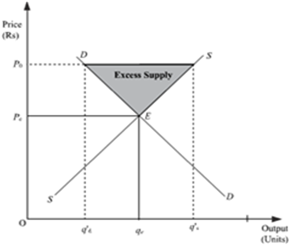Sponsor Area
Market Equilibrium
Giving reasons, state whether the following statements are true or false.
When equilibrium price of a good is less than its market price, there will be competition among the sellers.
True, when equilibrium price of a good is less than its market price then there will be competition among the sellers. At a price lower than market price, there will be more supply. This is explained with the help of the following diagram.
In the above diagram, point E is the equilibrium point, where the market demand curve DD and the market supply curve SS intersects each other. At this point the equilibrium price is OP and the equilibrium quantity is OQe
Now, suppose the market price is OPo, the equilibrium price is less than the market price. At this price the market demand is OQd and the market supply is OQs. Clearly, market supply is more than the market demand. So, there exists a situation of excess supply. Due to excess supply, there will exist competition among the sellers.
Some More Questions From Market Equilibrium Chapter
Market for a good is in equilibrium. There is simultaneous increase both in demand and supply of the good. Explain its effect on market price.
Market for a good is in equilibrium. There is simultaneous decrease both in demand and supply of the good. Explain its effect on market price.
Market for a good is in equilibrium. There is an 'increase' in demand for this good. Explain the chain of effects of this change. Use diagram.
What is minimum price ceiling? Explain its implications.
If the prevailing market price is above the equilibrium price, explain its chain of effects.
The demand of a commodity when measured through the expenditure approach is inelastic. A fall in its price will result in :
(choose the correct alternative)
(a) no change in expenditure on it.
(b) increase in expenditure on it.
(c) decrease in expenditure on it.
(d) any one of the above
(choose the correct alternative)
(a) no change in expenditure on it.
(b) increase in expenditure on it.
(c) decrease in expenditure on it.
(d) any one of the above
As we move along a downward sloping straight line demand curve from left to right, price elasticity of demand : (choose the correct alternative)
(a) remains unchanged
(b) goes on falling
(c) goes on rising
(d) falls initially then rises
(a) remains unchanged
(b) goes on falling
(c) goes on rising
(d) falls initially then rises
Define market demand.
Show that demand of a commodity is inversely related to its price.
Explain with the help of utility analysis.
Or
Why is an indifference curve negatively sloped? Explain.
Explain with the help of utility analysis.
Or
Why is an indifference curve negatively sloped? Explain.
When price of a commodity X falls by 10 per cent, its demand rises from 150 units to 180 units. Calculate its price elasticity of demand. How much should be the percentage fall in its price so that its demand rises from 150 to 210 units ?
Sponsor Area
Mock Test Series
Mock Test Series





